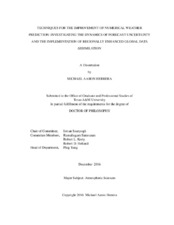| dc.contributor.advisor | Szunyogh, Istvan | |
| dc.creator | Herrera, Michael Aaron | |
| dc.date.accessioned | 2017-03-02T16:51:17Z | |
| dc.date.available | 2018-12-01T07:20:32Z | |
| dc.date.created | 2016-12 | |
| dc.date.issued | 2016-11-16 | |
| dc.date.submitted | December 2016 | |
| dc.identifier.uri | https://hdl.handle.net/1969.1/159097 | |
| dc.description.abstract | This dissertation describes and shows results from two projects which focused on investigating and improving current methods of numerical weather prediction. First, we show a new data assimilation (DA) approach that produces a global analysis that is enhanced by information from multiple regions of a limited area model (LAM). The enhancement is introduced by blending the model states from the global and regional models and using the blended state to compute the innovations (the difference between the observations and their predicted value). The approach is tested by an implementation on the US Navy’s operational global data assimilation system and global and limited area numerical weather prediction models. The resulting system is evaluated by month long analysis-forecast experiments. It is found that REG DA can provide improved global forecasts with the largest improvements observed for Hurricane Sandy and frontal passages over the central plains. This result suggests that operational NWP centers that produce both global and regional forecast products could potentially improve their global forecasts without a significant increase in computational resources by implementing the proposed approach.
Next, we employ local linear, spatial spectral, and Lorenz-curve based diagnostics to investigate the dynamics of uncertainty in global numerical weather forecasts in the NH extratropics. The diagnostics are applied to ensembles in the THORPEX Interactive Grand Global Ensemble (TIGGE). The initial growth of uncertainty is found to be the fastest at the synoptic scales (zonal wave numbers 7-9) most sensitive to baroclinic instability. At later forecast times, the saturation of uncertainties at the synoptic scales and the longer sustainable growth of uncertainty at the large scales lead to a gradual shift of the wave number of the dominant uncertainty towards zonal wave number 5. At the sub-synoptic scales, errors saturate as predicted by Lorenz’s classic theory. While the ensembles capture the general characteristics of the uncertainty dynamics efficiently, there are locations where the predicted magnitude and structure of uncertainty have considerable time-mean errors. In addition, the magnitude of systematic errors in the prediction of the uncertainty increases with increasing forecast time. These growing systematic errors are dominated by errors in the prediction of low frequency changes in the large scale flow. | en |
| dc.format.mimetype | application/pdf | |
| dc.language.iso | en | |
| dc.subject | data assimilation | en |
| dc.subject | numerical weather prediction | en |
| dc.subject | ensemble forecasting | en |
| dc.subject | forecast uncertainty | en |
| dc.title | Techniques for the Improvement of Numerical Weather Prediction: Investigating the Dynamics of Forecast Uncertainty and the Implementation of Regionally Enhanced Global Data Assimilation | en |
| dc.type | Thesis | en |
| thesis.degree.department | Atmospheric Sciences | en |
| thesis.degree.discipline | Atmospheric Sciences | en |
| thesis.degree.grantor | Texas A & M University | en |
| thesis.degree.name | Doctor of Philosophy | en |
| thesis.degree.level | Doctoral | en |
| dc.contributor.committeeMember | Saravanan, Ramalingam | |
| dc.contributor.committeeMember | Korty, Robert L | |
| dc.contributor.committeeMember | Heltand, Robert D | |
| dc.type.material | text | en |
| dc.date.updated | 2017-03-02T16:51:17Z | |
| local.embargo.terms | 2018-12-01 | |
| local.etdauthor.orcid | 0000-0003-0815-4496 | |


